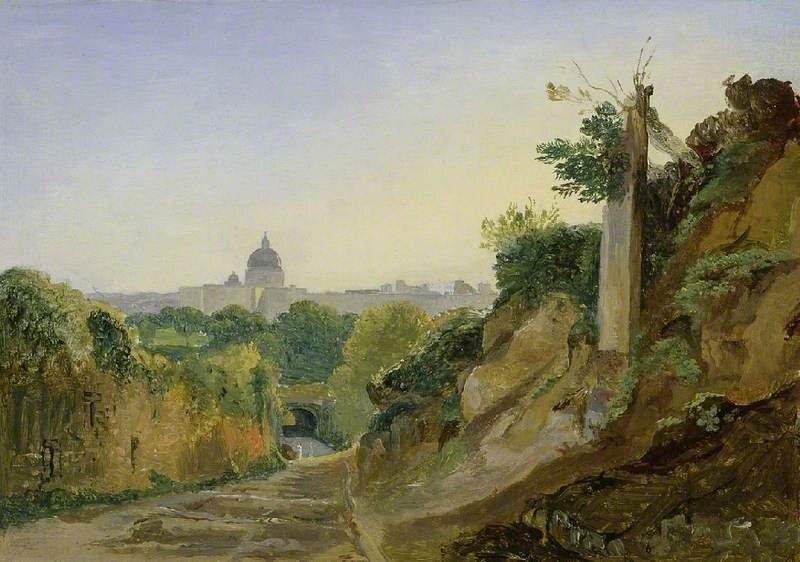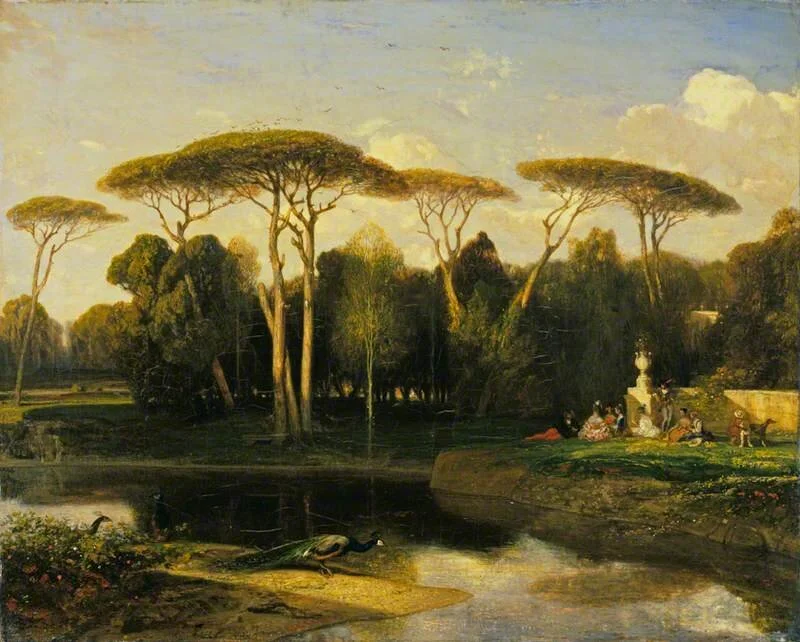Rome from Home by Catherine Fletcher
André Giroux (1801-1879), A View of Rome. The Fitzwilliam Museum. Used under a CC BY-NC-ND licence.
Karl Heffner (1849-1925), The Aqueduct of Claudius, Rome. Touchstones Rochdale. Used under a CC BY-NC licence.
All roads lead to Rome, goes the saying, but they didn't in 2020 and nor do they in 2021. I've been to Rome before, but I'm not going now. I'm here, in Manchester. The nearest I get to Rome is Castlefield, where the remains of the Roman castrum that put the Chester into Manchester have been dug round into a garden, and a city gate mocked up, here at the far end of what was the Roman Empire.
In May 2020, locked down, without much else to do in my spare time, I drafted the schedule for a new project. It might take a while to get back to travelling, but surely in twelve months I might make it to Rome. Via Francigena, I wrote. May 2021.
Planning a book on the roads to Rome I had all the city's images in mind: the particulars of light, the whispering pines, the pavements made up of small square stones, in Italian pietrini. The great dome of St Peter’s and its lesser cousins. The Colosseum. Palaces, facades, orders, rustication. Shades of terracotta. Ruins, always ruins. The view across to the Vatican from the Pincio, or of the aqueducts beside the Via Appia. That’s the Rome that thousands paint and draw, but I watched Rome online, locked down. The empty Trevi fountain, captured in rare snaps. The bare streets, strange and still without their travellers. Rome unpeopled.
Beatrice Mary Seccombe Leech (1880-1945), Rome, from the Pincio, Piazza Del Popolo, 1933. Manchester Art Gallery. Used under a CC BY-NC-ND licence.
By early 2021 I’d rewritten my plans, pushed my travel back to 2022. Maybe Italy would be feasible in the summer, just, but my vaccine wouldn't kick in until July, and even if I could bear to sightsee in the heat, Rome takes its holidays in August. I became an armchair traveller, of sorts, though I'm not sure that's precisely the right term. I know Rome well. I went there first in 2001, for a language course. I returned the following summer, with a travel bursary from college. I lived in Rome for six months in 2006 and went back for another nine in 2009-10. I've turned up for weeks, and weekends, and a month in the summer on occasions since.
Those weeks and months gave me other views. Not only the communal experience, the vistas that for centuries tourists have been instructed to enjoy, but the ones acquired by being present, by standing on that hill for yourself and seeing the skateboarders from the corner of your eye, or by perching at that courtyard table with a glass of wine and hearing bar staff argue. My remembered Rome has palm trees and parakeets, a view of fireworks from the roof for some Roman holiday. It has a street where the residents colour-code their laundry on the line for the perfect tourist shot. It has breakfast for a euro, or it did, and all-you-can eat brunches for occasions when I had cash to spend. It has trips on miniature buses that hum through central streets, and morning walks past machines that scrub clean the pietrini. Underneath the vaults of one old house it has an air-conditioned gym, though when the exchange rate went bad I switched to running in the park, back beneath the pines. Rome has fried snacks on marble tables and late at night a bar beside a fig tree. It has Mondo Arancini, which late in the day we discovered would deliver those deep-fried balls of rice with tasty fillings. It has ice-cream on an island and quiet walks along neglected riverbanks. It has a guerrilla museum out of doors, along a wall beside the Ara Pacis. Perhaps it doesn’t any more, now they’ve renovated the mausoleum of Augustus that sits next door.
Alexandre-Gabriel Decamps (1803-1860), The Villa Doria Pamphilj, Rome. The Wallace Collection. Used under a CC BY-NC-ND licence.
I don’t know, because I can’t go back. The roads to Rome are closed, and not for the first time. Wars have stopped these roads before: Lombard invaders blocked the Via Flaminia in the eighth century; a millennium later the Napoleonic Wars put a halt to tourism. Nor is it the first time that disease has held up travel. In the sixteenth century, Michel de Montaigne was obliged to show a ‘bulletin of health’ to confirm that he didn’t have the plague.
I make the best of what I can recall from my own memories and imagine from the tales of others. The sparse lists of churches drawn up by early pilgrims: catalogues of Rome with their occasional notes of wonder. The appalled musings of scandalised Protestants. The practical advice of Mrs Mariana Starke, who noted in her letters which museums were cold because her frailer readers wouldn’t want to catch a chill. I like Mrs Starke. I've worn the wrong clothes in Rome, been too hot, too cold, miscalculated. One trip I had to do a whole stack of shopping because the season changed too soon. Those pilgrim routes and museum meanderings map on to my own. One itinerary reminds me of the number 3 tram, when it ran on its full route.
I find Rome all over. The city moves. Napoleon relocated bits of Rome to Paris, stealing paintings, ripping off its monuments for his own Arc de Triomphe. On the Rajpath in Delhi the British rulers of India put up a triumphal arch too. Even here at home in Manchester I have more than just the remnants in Castlefield. I have architects’ imaginings on the fronts of buildings, in classic colonnades. On the canals the geese outdo the sacred geese of Juno that are said to have saved Rome: ours are fierce enough that they'd fight off the Gauls themselves.
What does it mean to write a place from memory? What do we forget? What have we chiselled off? Sometimes, in Rome, they’ve chiselled off what's not to be remembered, and not only back in ancient times. I’ve seen spots where M for Mussolini is now gone. It’s often said that Rome’s a city of layers, and you see that in its churches stacked one above the other, in its houses curling into ancient walls. Memory’s another layer, but it’s not only a layer. It’s a filter, too. It cuts out certain lights and brightens others. I know this, and still, it leaves me with a place that lives in words and pictures. Rome, from home.
Allan Newton Sutherland (c. 1885-1918), River Tiber and Castel Sant'Angelo, Rome. Aberdeen Art Gallery & Museums. Used under a CC BY-NC licence.




